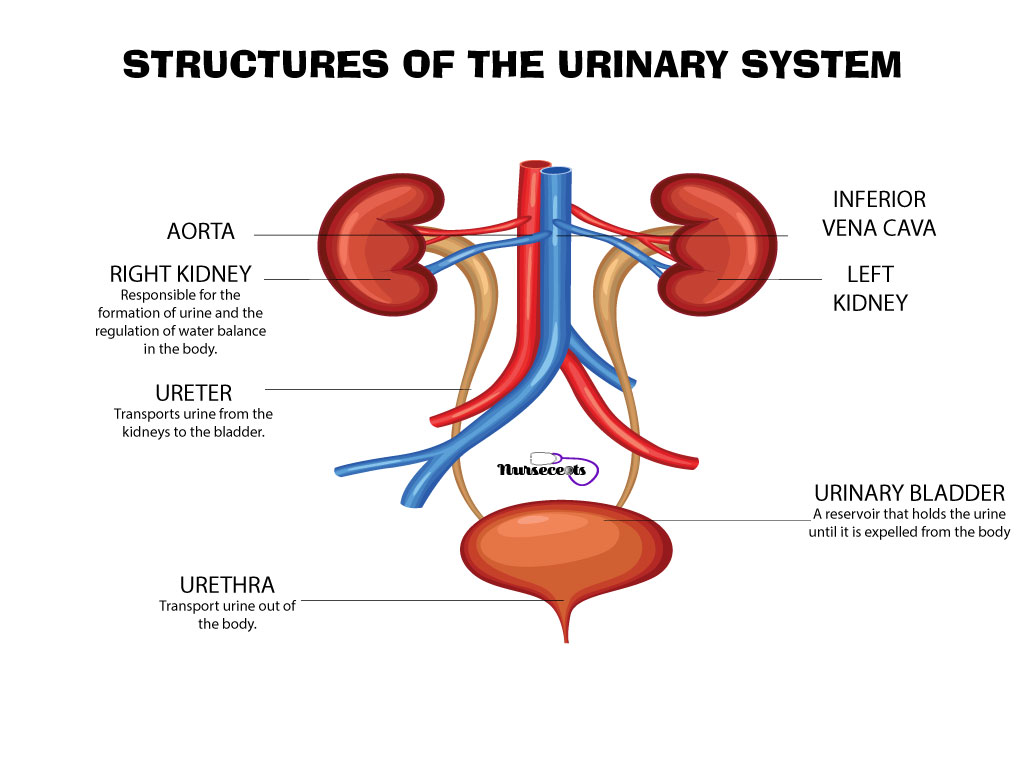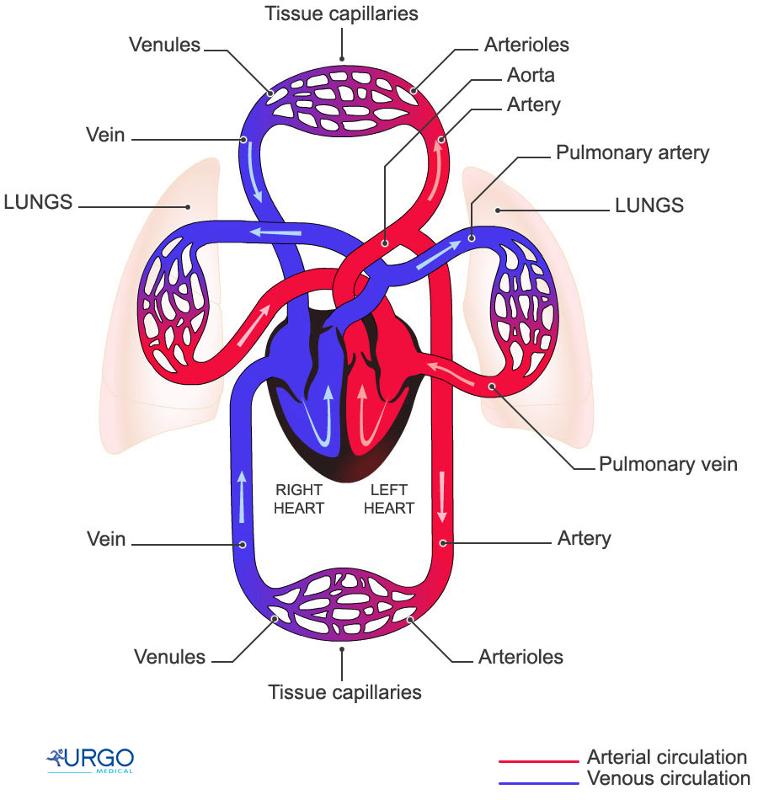The most common and important organ system present in the human body is the respiratory, circulatory, endocrine, digestive, reproductive, integumentary and nervous systems (Tortora and Derrickson, 2018). All these systems have specific functions, but they cannot independently function as they rely on one another to work properly. Each system is important for the normal body function and that is why every person has them. The text, therefore, discusses the urinary and cardiovascular systems in the human body.
The Urinary System
The excretory system comprises of kidneys, ureters, an urinary bladder plus urethra, as shown in figure 1, providing the structures of the urinary system. The main purposes of the urinary system include reabsorption, filtration and secretion. The kidneys sift the blood to eliminate metabolic wastes and then transform the resulting fluid, which lets these organs balance fluid, acid-base, electrolyte and blood pressure homeostasis (Ridley, 2018). This process yields urine, a fluid that consists of electrolyte, water and metabolic wastes. The other components of the urinary tract transfer, store, and eliminate urine from the body.

The kidneys eliminate urea from the blood by nephrons that entail glomerulus and renal tubule. The nephron has two key divisions, that is the renal capsule and tubule. The renal tubule is responsible for purifying blood, and it comprises two parts, the glomerular capsule and the Bowman’s capsule. The renal tubule is a twisting tube liable for transforming the filtrate. It consists of three parts: the nephron loop, proximal tubule, plus distal tubule, each of which varies in structure and role. Arterial blood goes into Bowman’s capsule from the afferent arteriole then gets sifted in the glomerulus.
Red blood cells, proteins and white blood cells are too large to pass through the fenestration in the glomerulus, but water, glucose, electrolyte and acids go through. The filtrate moves to the proximal convoluted tubule from the Bowman’s capsule, where 80% of the substances are reabsorbed into the peritubular network (Bagga et al., 2016). The filtrate then enters the loop of Henle, which let water to be reabsorbed under specific conditions. The water then enters the peritubular network from the loop of Henle. The distal convoluted tubule helps regulate sodium plus water levels which plays an essential role in homeostasis regulation. At the end of the collecting duct, the urea turns into urine that is not taken back by the body. Therefore, it passes into the renal pelvis then down the ureters into the urinary bladder, exiting via the urethra.
The Cardiovascular System
The cardio-vascular system is also referred to as the circulatory system, and it comprises three main components: the heart, blood vessels, and the blood. As the name suggests, the blood in the circulatory system is propelled by the heart in a closed circuit as it passes continuously through several circulations of the body. The primary function of the circulatory system includes working in combination with the breathing system to transport oxygen to tissues of the body and exclude carbon dioxide (Hughson, Helm and Durante, 2018), as shown in figure 2 below.
Second, protecting the body from infections and blood loss because blood comprises three essential cells red and white blood cells and as well as platelets. The erythrocytes are responsible for moving oxygen around the body to the organs and tissues that need it. White blood cells identify foreign antigens and guard the body against infections. Platelets are responsible for clotting the blood in case of an injury, therefore, preventing excessive loss of blood, as well as thermoregulation and fluid balance within the body.

The following information describes the structure and functions of two major parts of the cardiovascular system.
The Heart
The heart is a muscular organ that is a core part of the cardiovascular system. It offers the force necessary to flow the blood to all parts in the body (Peate, 2018). It is separated into two parts: a right plus left side, by a muscular septum, as shown figure 3, the internal view of the heart. The heart has two chambers, where the two upper compartments are the right and left atria, which receive blood from various sections of the body. The right atrium collects blood from the entire body parts, while the left atrium takes in blood from the lungs. The two bottom cavities are known as the right and left ventricles, which propel blood to various parts of the body. The left ventricle drives out blood to the entire body parts, while the right ventricle pumps blood to the lungs to be oxygenated.

Blood Vessels
These are channels by which blood is circulated to body tissues, and they form two closed systems of tubes. Grounded on their function and structures, blood vessels are categorized into either capillaries, veins or arteries (Sivaraj and Adams, 2016). The tiniest and most abundant blood vessels are the capillaries, and they form the linking between the vessels that transport blood from and back to the heart. Their primary role involves the interchange of material between the blood plus tissue cells. Arteries, on the other hand, carry blood out of the heart and consist of two types.
First, the systemic arteries that carries oxygenated blood from the left chamber to the body tissue. And second, pulmonary vessel transport blood low in oxygen from the right chamber of the heart to the lungs. On the other hand, the vein carries the blood back to the heart through venules after passing the capillaries. The walls of the veins are stripper than that of capillaries and arteries, therefore less rigid and can hold more blood (van Hinsbergh, 2017).
Self-Reflection Part
My first time in a medical class, I remember; clearly, the lecturer told us to go and remind ourselves what we were taught in high school biology about the organs systems. I could only remember that the body is made up of several systems functioning together to keep me fit and strong. But after the second lecture we majored on the urinary system, I understood that it operates like a plumbing system. This is because it comprises various components that work collectively to produce, stock and remove urine from the body.
I learned that the urinary tract system is an essential part of the body’s general maintenance as it functions to regulate homeostasis and release necessary hormones, and the kidney is the most significant organ. At the end of the first semester, we did a project as a class to find out why there was a massive rise in kidney failure in Irish patients. Unfortunately, we found out that Chronic Kidney Disease is a usual chronic ailment that affects 15% of adults in Ireland (Mohammed, et al., 2019).
In addition, I learnt that the heart is vital because it is the pump that forces the blood around the circulatory system of the body to provide organs like kidney, liver, and digestive system organs with blood and nutrients for survival. According to the Institute of Public Health, the number of Irish adults with cardiovascular disease will increase by around 21 % around 2021 (Halloran, et al., 2021). Therefore, required urgent community-based care and support service. Besides, about 6,000 people have heart attacks in Ireland each year, and men are seven times more likely to die from cardiovascular disease than women. When the lecture gave us those statistics, everyone in the class knew the importance of understanding the cardiovascular system. After the medical class, I realized that the heart is the core of the cardiovascular system and any damage to it affects the entire system.
Reference List
Bagga, A., et al. (2016) ‘Renal anatomy and physiology’, Paediatric Nephrology, p.1.
Biology, p.17.
Halloran, A.M., et al. (2021) ‘Informing patterns of health and social care utilisation in Irish older people according to the Clinical Frailty Scale’, medRxiv.
Hughson, R.L., Helm, A. and Durante, M. (2018) ‘Heart in space: effect of the extraterrestrial environment on the cardiovascular system’, Nature Reviews Cardiology, 15(3), p.167.
Ignatavicius et al. (2020) Medical-Surgical Nursing-E-Book: Concepts for Interprofessional Collaborative Care. Elsevier Health Sciences.
Mohammed, E., et al. (2019) ‘Prevalence and treatment of gout among patients with chronic kidney disease in the Irish health system: a national study’, PloS one, 14(1), p.e0210487.
Peate, I. (2018) ‘Anatomy and physiology, 8. The circulatory system’, British Journal of Healthcare Assistants, 12(2), pp.62-67.
Ridley, J.W. (2018) ‘Metabolic Origins of Urine and Other Body Fluids’, In Fundamentals of the Study of Urine and Body Fluids (pp. 45-60). Springer, Cham.
Sivaraj, K.K. and Adams, R.H. (2016) ‘Blood vessel formation and function in bone’, Development, 143(15), pp.2706-2715.
Tortora, G.J. and Derrickson, B.H. (2018) Principles of anatomy and physiology. John Wiley & Sons.
van Hinsbergh, V.W. (2017) ‘Physiology of blood vessels’, The ESC Textbook of Vascular.